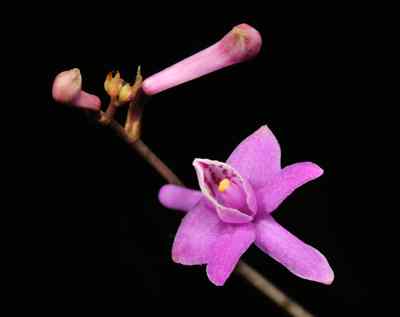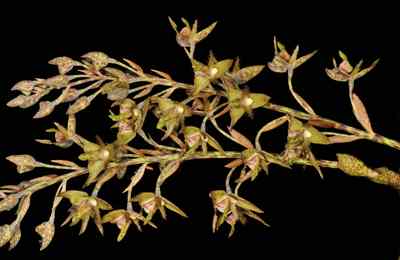The Plant
Epiphyte. Pseudo-bulbs, crowded, conical, slightly flattened, 1 cm in height and 1. 2 to 1.8 cm in diameter at its base, with many woody roots; wrinkled during flowering. Leaves in pair, arising from the apex of the bulb, oblong, narrowed to the base, sessile, 4 to 7 cm long and 1 to 1.5 cm in width, deciduous during flowering. Flowers in scape arising from the base of the bulb. Peduncle erect or diagonally erect, with two ovate clasping bracts at equal distance from the base of the scape, 4 to 9 cm long. Raceme pendulous, 6 to 14 cm long, many flowered.
The Flower
Flowers pendulous, arranged spirally. Sepals unequal, lanceolate, ciliolate, less than 1 cm long; lateral linear, both fused together except at its base to form an oblong shape and partially twisting along the middle, laxly ciliolate, 4 to 7 cm long and 0.8 to 1.2 cm in width, 10 to 12 veined. Petals very small, triangular, densely ciliolate. Lip longer than petals but shorter than the lateral sepals, fleshy, oblong, lower surface convex, hairy. Floral bracts from the upper side of the short sessile ovary, lanceolate. Flowers with a soothing scent.
Dorsal sepal, petals and lip are whitish brown base with broad markings of purple, the marginal hairs of sepals and petals as well as the lip hairs are dark purple. Lateral sepal which forms the most attractive part of this flower are bright yellow mixed with purple shade, its base with minute purple dots; but turns brownish yellow when old. Floral bract pale brown.

The Pursuit
King and Pantling described this species as “a curious plant”. It is true anyone who has seen this flower once will never forget it. I was aware about the peculiar shape of this orchid flower and was studying it much before I started my work on orchids of the region. In the winter months I made a couple of trips to the Himalayas for finding this, but those short trips never brought any results other than enjoying the coolness of the Himalayas.
When I started living in the region from 2011 with the current project, my first intention was to see and document this flower. I enquired about this plant wherever I went and whomever I met in connection with my work. Finally in the early winter month I met a group of villagers who had seen this in flower in a forested area near their village. After several calls and a lot of coordination, a few of those villagers accompanied on the pursuit. We were 4 people on that particular day and searched by climbing up several trees. Unfortunately we were not able to spot the plants. That year was not fruitful in spotting the species.
In 2012, I was traveling to a distant village, which is in a deep valley surrounded by semi tropical dense forested hills on a friend’s bike. On this particular day I was on hunt for another plant. We were there by 9 in the morning and did its documentation very well, had a small survey of the surrounding area till noon. After having lunch from there we were riding back, this time I tried my luck with the handle bar. The ride was almost uphill all the way back and needed careful riding. Hence I was concentrating on the forest road to negotiate the vehicle properly. Almost half way on the uphill road, I spotted something strange on top of a tall tree to the right side of the road. Immediately I stopped the vehicle for a close look. To my surprise I found two plants of this species in full bloom. I will never forget that moment, as it is a bonus to find two plants in full bloom!!! Both of them were on a thin branch almost 60 ft high. The branch was extending to the road and was almost 16 to 20 ft long. There was no way to reach it. Even if we climb the tall tree, we would not be able to reach the flowers, as the branch in which it was growing was very thin and would not hold my weight. We both thought of many ideas but without any success. The village, which we visited, was more than 17 km away and bringing somebody from there for help was also not feasible on that day as it was already evening. We returned with great disappointment. I was not able to sleep even for a minute on that night, my mind was thinking about various ideas to reach those flowers.
Next day, we went again to the spot to try our luck, with two long ropes and the local knife, “the kukri”. After many rounds of ideas and suggestions, it was decided to break the branch of that tree and bring down the plants, study and document them and replant those plants to another branch. I never advocated cutting down any branches or pulling out any plants from its natural habitat. But in a situation like this I was left with no other options. Before taking a final decision we both surveyed the entire area to look for any other specimens but in vain. Then we decided to go for the most painful decision of my orchid hunt in the Himalayas till date. My friend climbed up the near by tree and tied a long rope to the apex end of the branch with flowers. Simultaneously I roped the other end to the trunk of the tree. Then, I started cutting the branch with great care and detached it from the trunk. Now, the thin branch was up there with the support of those ropes tied to its either sides. We untied those ropes and lowered the branch to ground level with utmost care. We came down the tree and I have no words to describe my first close view of this beautiful orchid flower. The next couple of hours were with notebook and camera for documenting it. Noted down all its characteristics, checked it several times to make sure everything was right and documented those flowers until a whole bag of flash batteries got drained out.
Then came the most important part of the current hunt, “to replant those plants”. I read many articles by eminent scientists from the Neo Tropical region and their way of trans-locating plants from fallen trees to new locations. Taking much clue from those notes and directions we trans-located those 11 buds to a new branch. Later on, in the coming weeks I made several visits to the locations to make sure the plants are growing in their new locations.
Last year, around the same time I found 6 flowering scape and the number of bulbs increased to 16. That sight had given me more joy than the find of this species exactly one year before. The Lord has answered my prayers for not being the reason for the extinction of this species at least from that location.
Reference:
King, G. & Pantling, R. (1898). The Orchids of the Sikkim-Himalayas. Ann. Roy. Bot. Garden. (Calcutta). Cirrhopetalum refractum Zollinger., Page no 87.








